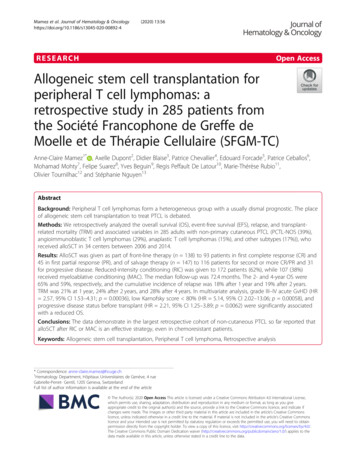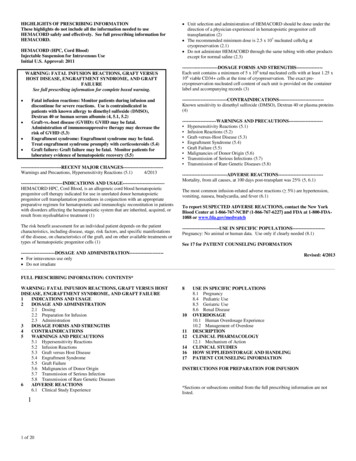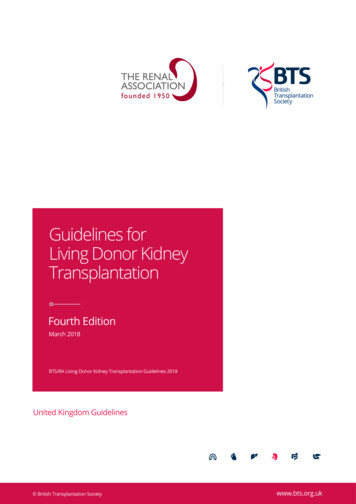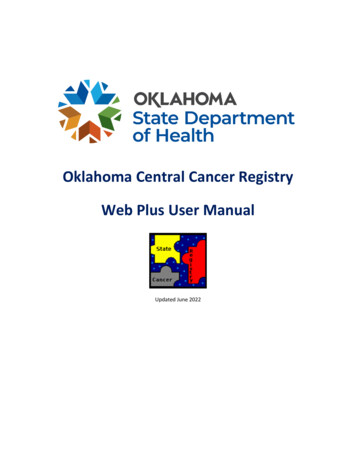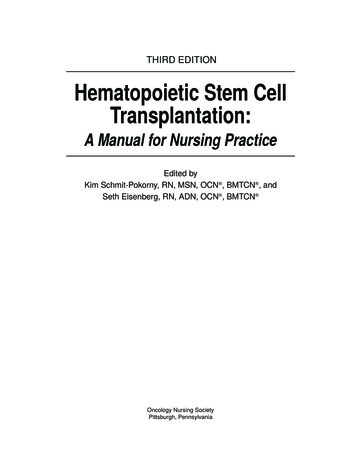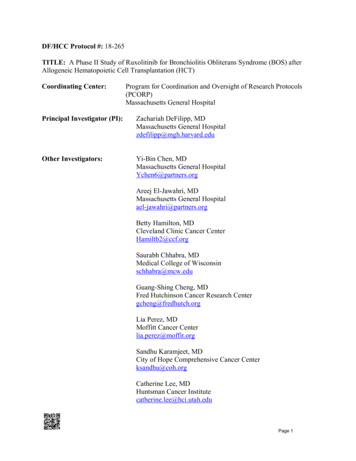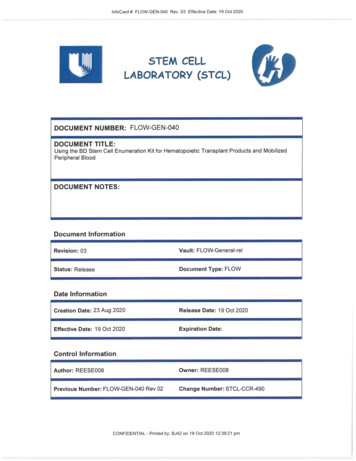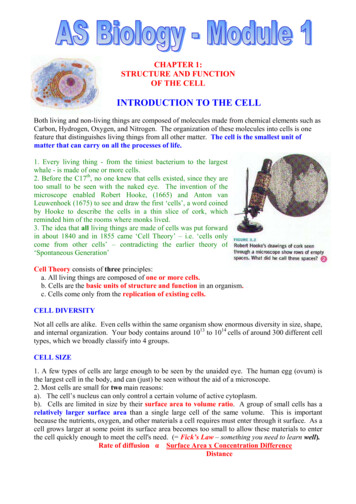
Transcription
Combining blinatumomab and donor lymphocyteinfusion in B-ALL patients relapsing after allogeneichematopoietic cell transplantation: A study of theSFGM-TCPaul Chauvet ( chauvet.paul@outlook.fr )CHRU Lille, Université de Lille https://orcid.org/0000-0001-6326-9283Annalisa PaviglianitiMyriam LabopinHôpital Saint-Antoine https://orcid.org/0000-0003-4514-4748helene labussiereCentre Hospitalier Lyon SudNicolas BoisselMarie RobinAPHP Saint Louis Hospital https://orcid.org/0000-0003-1388-9876Natacha MaillardMarie Ouachée-ChardinIHOPEdouard ForcadeBordeaux University Hospital https://orcid.org/0000-0002-8873-2868Xavier PoiréCliniques Universitaires St-Luc https://orcid.org/0000-0003-1897-0227Sylvain ChantepieInstitut d'HématologieAnne HuynhIUCT OncopoleClaude-Eric BULABOISCentre Hospitalo-Universitaire GrenobleMathieu LeclercSébastien MauryAP-HP, Groupe Hospitalier Henri-Mondor Albert-ChenevierPatrice ChevallierCHU Hotel DieuThomas CluzeauCHU of Nice https://orcid.org/0000-0002-6745-1127Page 1/21
Jean-Baptiste MearCentre Hospitalier Universitaire de RennesJerome CornillonInstitut de Cancérologie Lucien Neuwirth https://orcid.org/0000-0001-9830-8940Karin BilgerCHRU StrasbourgCelestine SIMANDInstutit of Cancerology, Strasbourg.EuropeYves BeguinUniversity of LiègeMarie-Thérèse RubioCHRU Nancyibrahim yakoubaghaCHU LilleEolia BrissotHôpital Saint Antoine, Service d'Hématologie et Thérapie CellulaireArticleKeywords: blinatumomab, DLI, donor lymphocyte infusion, hematopoietic stem cell transplantation, acutelymphoblastic leukemiaPosted Date: June 22nd, 2022DOI: : This work is licensed under a Creative Commons Attribution 4.0 International License.Read Full LicensePage 2/21
AbstractRelapsed B-cell acute lymphoblastic leukemia (B-ALL) after allogeneic stem cell transplantation (alloHCT) still represents a major concern with poor outcomes. The aim of this study is to compare theefficacy and safety of blinatumomab and donor lymphocyte infusion (DLI) versus blinatumomab alone inthis setting. This is a multicenter retrospective study from centers of SFGM-TC. All transplanted patientswho received blinatumomab salvage therapy were included. Patients who received DLI from 1 monthbefore to 100 days after the starting of blinatumomab were included in the blina-DLI group. Seventy-twopatients were included. Medium follow-up was 38 months. Fifty received blinatumomab alone and 22 theassociation blinatumomab-DLI. Two-year overall survival (OS) was 31% in the blinatumomab group and43% in the blinatumomab-DLI group (p 0.31). Studying DLI as a time dependent variable, PFS did notsignificantly differ between the 2 groups (HR:0.7, 95%CI:0.4-1.5). In multivariate analysis, DLI was not aprognostic factor for OS, progression-free survival and progression/relapse incidence. Adverse events andgraft-versus-disease rates were comparable in the 2 groups. In conclusion, adding DLI between 1 monthbefore and 100 days after start of blinatumomab is safe and does not seem to improve outcomes in BALL patients who relapsed after allo-HCT.IntroductionAllogeneic hematopoietic cell transplantation (allo-HCT) is still a standard of treatment in a subset ofpatients with B-cell acute lymphoblastic leukemia (ALL)(1). However, post-transplant relapse isassociated with poor outcome with a median overall survival (OS) below 6 months(2–4). In addition,approximately 60-70% of the patients never achieve a second remission(5). Despite recent improvementsin ALL treatment, therapeutic options for post-transplant relapse remain limited. Especially, chemotherapyalone does not seem to be an effective option as reported in previous studies(2,6).Over the last decades, donor lymphocyte infusion (DLI) has been used as a salvage therapy after posttransplant relapses in B-ALL patients with a proven antileukemic effect(7,8). Nevertheless, the completeresponse rate does not exceed 30% in prospective studies or systematic reviews, and long-lasting controlof the disease is rare(9–11). In addition, DLI can trigger graft-versus-host disease (GVHD)(12) that can beresponsible for high incidence of morbidity and mortality. Second allo-HCT is not always feasible, andoutcome after second transplant seems to be similar to those observed after DLI(13,14).Blinatumomab (blina), a CD3/CD19 bispecific antibody acting as a T-cell engager, has been approved inthe treatment of refractory/relapsed B-ALL(15). A few publications reported the association of blina andDLI in the literature. Stein and al. reported the use of blina in B-ALL patients who relapsed after allo-HCTdescribing a CR rate of 45% with a median relapse free survival of 7 months in responders(16).We conducted a retrospective multicenter study on B-ALL patients who relapsed following allo-HCT inorder to compare the safety and efficacy of blina versus blina in association with DLI.Page 3/21
MethodsPatients and data collectionSeventy-two allografted adult or pediatric B-ALL patients who received blina with or without DLI as asalvage therapy after post-transplant relapse were included. Only patients who received at least onecomplete cycle of blina were included. Patient received blina alone or blina and DLI according to centerpolicy. Blina and DLI exact modalities were at the discretion of each center. Of note, a cycle of blinaconsisted of 28 days of continuous intravenous infusion of blina followed by a period of 14 days oftreatment-free interval(17).The study was conducted between January 2012 and December 2018 in 25 centers belonging to theFrancophone Society of Bone Marrow Transplantation and Cellular Therapy (SFGM-TC). This study wasapproved by the SFGM-TC scientific board and was conducted in agreement with the declaration ofHelsinki. Clinical data were obtained from the ProMISe (Project Manager Internet Server) database. Allpatients or their legal representative provided written informed consent for the use of their data forclinical research.Statistical analysisComplete response (CR) was defined as the presence of less than 5% blasts in the bone marrow with noextramedullary disease (e.g., central nervous system or soft tissue disease) associated with peripheralhematologic recovery.Minimal residual disease (MRD) response was defined as a CR without any detectable disease,irrespective of the employed marker (e.g., rearranged immunoglobulin gene) or technic (Sanger,polymerase chain reaction, next generation sequencing or multiparametric flow cytometry).Adverse events (AE) were recorded and classified according to the Common Terminology Criteria forAdverse Events (CTCAE)(18).GVHD was recorded using the modified Glucksberg criteria for acute GVHD (aGVHD)(19) and the 2014revised National Institutes of Health (NIH) Consensus Conference criteria for chronic GVHD (cGVHD)(20).Patients who received a DLI from 1 month before to 100 days after start of blina were included in theblina-DLI group. Patient’s disease, and transplant-related characteristics for the two cohorts (blina alone /blina-DLI) were compared by using χ2 or Fisher statistics for categorical variables and the Mann-Whitneytest for continuous variables.The primary endpoint was OS defined as the time from the start of blina treatment to death or last followup. Patients alive at last follow-up were censored.The secondary endpoints were CR after blina, progression-free survival (PFS), relapse/progression, nonrelapse mortality (NRM), AE and GVHD occurring after blina. PFS was defined as survival with noPage 4/21
evidence of relapse or progression. Relapse was defined as the presence of 5% BM blasts and/orreappearance of the underlying disease. Patients who did not experience CR were considered as relapsedat time of no CR. Patients alive without disease at last follow-up were censored. NRM referred to deathfrom any cause without previous leukemia relapse/progression.Cumulative incidence was used to estimate the endpoints of CR and relapse/progression, death being thecompeting event. Probabilities of OS and PFS were calculated using the Kaplan–Meier method.Comparison between the 2 groups was performed using extended Cox model including DLI as a timedependent variable. In addition, a landmark analysis was performed for comparison of OS in patientsalive at day 100 post blina. Multivariate analysis was adjusted on patient age, patient sex, donor type(matched sibling donor (MSD) vs other), time from allo-HCT to relapse and time from relapse to blina.Analyses were performed with SPSS 25 SPSS 27 (IBM SPSS Statistics for Windows, IBM Corp, Armonk,NY) and R 4.1.1 (R Core Team (2021). R: A language and environment for statistical computing. RFoundation for Statistical Computing, Vienna, Austria. URL https://www.R-project.org/) softwarepackages.ResultsPatients and treatment characteristicsSeventy-two patients were identified. The baseline characteristics of patients are reported in Table 1. Fifty(69%) patients received blina as a single treatment (blina group) for relapse while 22 (31%) received blinain association with DLI (blina-DLI group). There were no significant differences between the two groups interms of patient and disease characteristics. Male gender accounted for 54% of the patients in the blinagroup and 68% in the blina-DLI group. The age distribution did not significantly differ between the twogroups and the pediatric population accounted for 3 (6%) and 4 (18%) of blina and blina-DLI groups,respectively, p 0.11. Thirteen patients had Philadelphia chromosome B-ALL subtype (PH ALL) in theblina group and 7 in the blina-DLI group. Thirteen patients (18%) had received blina prior to allo-HCT, 7(14%) in the blina group and 6 (27%) in the blina-DLI group (p 0.85). Disease status at the time of alloHCT, 45 (90%) of the blina group were in CR and 19 (86%) in the blina-DLI group.Types of donors and cell source did not significantly differ between the two groups (p 0.31 and p 0.2respectively). Fifty-seven patients (79%) received myeloablative conditioning (MAC) regimen while 15(21%) received reduced-intensity conditioning (RIC). MAC was used in 80% of patients in the blina groupand 77% of patients in the blina-DLI group (p 0.76). Total body irradiation (TBI) was part of theconditioning in 28 (56%) and 15 (68%) patients in blina and blina-DLI groups, respectively (p 0.33). ATGwas used in 36 (72%) patients in the blina group and in 8 (36%) in the blina-DLI group (p 0.004).As shown in Table 1, prior to B-ALL relapse, 22 patients (44%) of the blina-group and 6 (27%) of the blinaDLI group developed acute GVHD including 13 (26%) with grade 2 in the blina group and 4 (18%) withPage 5/21
grade 2 int the blina-DLI group. Twelve patients from the blina group (24%) and 5 (23%) from the blinaDLI group developed chronic GVHD including 9 and 3 patients with extensive form respectively.Post-transplant and pre-relapse anti-leukemia prophylaxisTwelve patients (17%) received a variety of post-transplant anti-leukemia prophylaxis according toinstitutional guidelines (i.e., tyrosine kinase inhibitors, prophylactic cranial irradiation and intrathecalchemotherapy injection). Of note, none of the patients received blina before relapse.Characteristics and management of post-HCT relapseDisease relapse/progression was only molecular in 7 patients (11%) and overt (hematological) in 59patients (89%) including 17 patients with extramedullary disease. These rates did not significantly differbetween groups (p 0.93). Main features of progression/relapse are described in Table 2.Patients received a median number of 2 [IQR1-3] cycles of blina in the blina group and 3 [IQR2-4] cycles inthe blina-DLI group (p 0.01). Blina was initiated in a median time of 22 days [IQR 10-62] after relapse.This period was 19 days [IQR 10-50] in the blina group and 22 [IQR 13-92] in the blina-DLI group (p 0.27).Blina was the first salvage therapy administered after allo-HCT in 40 patients (61%). This rate accountedfor 67% of patients in the blina group and 48% in the blina-DLI group (p 0.14).DLI was administered after a median time of 44 days [IQR 35-74] after blina initiation.Outcomes after blina with/without DLIThe median follow-up was 38.6 [95%CI 31.3-41.9] months. It was 39.5 [95%CI 34.6-53.8] months in theblina group and 27.6 [95%CI 19.1-41.9] months in the blina-DLI group (p 0.03). CR was obtained in 43/72(60%) patients, including 25 (50%) in the blina group and 18 (82%) in the blina-DLI group including 6patients achieving CR before DLI (p 0.018). Of note, more than a half of patients in CR obtained thisresponse after the first cycle (table 3). Less than 25% of patients only obtained CR after cycle 3-5.OS was 49.3% (37.3-60.3) at 1 year and 32 % (21.2-43.3) at 2 years (Table 4). PFS rates were 37.5% (26.148.9) and 23% (13.6-33.9), respectively. At 1 year, 59.4% (46.6-70.2) of patients relapsed or were inprogression. At 2 years this rate accounted for 68.9% of patients (56-78.8). Non-relapse mortality was 3%(0.5-9.4) at 1 year and 8.1% (2.9-16.8) at 2 years.DLI as time dependent variable was not significantly associated with outcome. For RI : HR 0.66 (95%CI :0.31-1.44) p 0.30, for OS : HR 0.64 (95%CI : 0.32-1.27) p 0.20 and for EFS : HR 0.73 (95% CI: 0.35-1.51)p 0.39.A landmark analysis was conducted on patients still alive at day 100 post blina (n 66). Two years OSrates were 43% (20.2-64) in patients who received blina-DLI and 30.5% (17.7-44.2) in patients whoreceived blina alone (p 0.31) (figure 1).Page 6/21
In multivariate analysis, patient age and time from relapse to blina were not associated with outcomes(Table 5). MSD was associated with significant lower PFS (p 0.046), with a trend for higher rates ofrelapse/progression (p 0.056). A longer time from allo-HCT to relapse was associated with better CRrates (p 0.03). Female sex was associated with better OS (p 0.042).Death was reported for 50/72 patients including 38 patients in the blina group and 12 patients in theblina-DLI group. Causes of death did not significantly differ between groups (p 0.76). Relapse accountedfor 71% of death (table 3). Other causes were infection (16%), GVHD (8%) and hemorrhage (2%).Adverse events and Graft Versus Host Disease after blina/blina-DLI treatmentMost frequent AE were hematological, neurological, and immunological, including cytokine releasesyndromes (CRS) (Table 5). AE rates were similar in the two groups except a low rate of neutropenia inthe blina-DLI group (Table 6). Among the whole cohort, hematological AE included neutropenia (13%),anemia (6%) and thrombocytopenia (8%). Neurological events were reported for 14 (19%) patients andincluded headache, encephalopathy, and peripheral neuropathy. Six neurological AE were grade 3 or 4. In14 patients (19%), immunological disorders were registered. Among them, 5 cases of CRS werediagnosed (7%) and 5 cases (7%) were registered as fever unrelated to infection and could be consideredas grade 1 CRS. Only 1 case of CRS was more severe than grade 2. Seven (10%) patients experienceddocumented infection.Three patients (6%) developed acute GVHD (aGVHD) after blina while 2 (9%) after blina-DLI (Table 6). Allbut one aGVHD cases were grade 2. Chronic GVHD (cGVHD) was diagnosed in 6 (12%) patients in theblina group, each in an extensive form. In the blina-DLI group, cGVHD accounted for 3 patients (14%)including 1 with extensive form.DiscussionPost-transplant relapse of B-cell acute lymphoblastic leukemia still represents today a critical conditionassociated with high mortality rates. In this retrospective study, we investigated the efficacy and safety ofblinatumomab, a CD3-CD19 bispecific antibody, combined or not with DLI in this specific indication.Firstly, we showed that the use of blina, even as single agent is associated with good response rates.Here, 60% of patients receiving blina or blina and DLI obtained CR as best response. Thirty-two patients(44%) obtained CR after 2 cycles of blina. These results are consistent with Stein et al(16). who found aCR / CR with partial hematologic recovery of peripheral blood counts (CRh) rate of 45% after 2 cycles.Among the whole cohort presented here, OS was 49.3% and 32% at 1 and 2 years, respectively. In Stein’sstudy, 1-year OS was 36%. Both of these results appear better than those obtained with chemo- orradiation-based salvage therapy even in association with second allo or DLI(6). Thus, our data confirmthat blina represents an effective option for salvage therapy after post-transplant relapse.Page 7/21
Secondly, we questioned the possibly of a synergy between blina and DLI. Indeed, blina is a T cellengager. By binding patient’s CD3-positive cytotoxic T cells, this bi-specific antibody allows them torecognize and finally eliminate CD19-positive ALL blasts(21–23). Consistent to that, baseline percentageof CD3 CD8 effector T cells has been shown to predict response to blina in refractory or relapsed BALL patients(24). Thus, effectiveness of blina probably depends on T cells recovery after transplant. Aspatients relapsing after transplant present a poorer immune reconstitution(25–27), optimizing thisreconstitution is probably a key to enhance blina efficacy.Here, the combination of DLI to blina did not seem to enhance its efficacy. Although, 81.8% of patients inthe blina-DLI group obtained CR, DLI considered as a time dependent variable was not statisticallyassociated with OS, PFS or relapse rates in multivariate analysis.Only a few cases of such combination have been reported in the literature. Durer et al., described a 51year-old woman who received 4 cycles of blina and 3 DLI. Because of an extramedullary associateddisease, she also received subsequent chemotherapy(28). This combined treatment conferred her morethan 14 months of complete remission. Ueda et al., reported the outcome of 4 patients treatedconcomitantly with blina and DLI. Two of them were still in complete remission after a respective followup of 7 and 13 months(29).Our study did not confirm a synergy between drugs. Nevertheless, it was conducted in a real-life mannerand reflects various and inhomogeneous practices. Administration of DLI concomitantly to blina infusionis probably a clue to obtain synergy. Indeed, blina has a short elimination half-life(30).Thirdly, administration of blina in combination or not with DLI appears to be safe. Indeed, the mostcommon AE were hematological, neurological, infectious and the induction of CRS. These AE are thoseclassically reported in phase 2(31–33) and phase 3(15) trials evaluating blina in relapsed or refractory Bcell ALL. No grade 5 toxicity has been reported. These AE are also consistent with those described inStein’s study(16). Considering GVHD, only a few data support its induction by blinatumomab. Khan andGul reported a 61-year-old woman with no history of GVHD developing gut and liver GVHD after 2 cyclesof blina. In the aftermath, she obtained a complete remission and a 100% positive donor chimerism(34).In Stein et al., 7 patients in 64 experienced GVHD after post-transplant blina(16). This rate wassubstantially lower than in our study. However, the study design in Stein’s trial systematically excludedpatients with active GVHD or receiving systemic treatment for GVHD prior to blina and could explain thedifference.Interestingly, we did not observe any strong excess of toxicity in the blina-DLI group. Both aGVHD andextensive cGVHD rates were also low in the combined treatment group. Thus, considering toxicities,combination appears feasible.In recent years, treatment of relapse of ALL dramatically changed thanks to several developments.Among them, CAR-T cell therapy is an exciting approach. Tisagenlecleucel shows remarkable efficacy inpediatric patients and young adults in clinical trials(35,36). After the ZUMA-3 phase 2 trial(37),Page 8/21
brexucabtagene autoleucel (KTE-X19) also obtained FDA approval The broad use of CAR-T cells in adultsis impeded by toxicities such as cytokine release syndrome or Imune effector cell-associatedneurotoxicity syndrome (ICANS)(38). Clinicians must also think about economical and organizationalissues related to this procedure(39). It is critical to consider that CAR-T cells are manufacturing productsengineered for each individual patient. Thus, obtaining CAR-T cells depend on the quality ofleukapheresis. This also induces a non-reducible manufacturing time which could be detrimental forpatients and even result in death. For instance, in the ZUMA-3 phase 2 trial, the median time fromleukapheresis to CAR-T manufacturing release was 13 days(37). In 71 enrolled patients, only 55 finallyreceived the KTE-X19 CAR T cells. Thus, blina represents an interesting alternative in a subset oftransplant patients who failed leukapheresis or are not responders to bridging therapy. As blina is an “offthe shelf” therapy, its use appears easier and faster.This study presents some limitations. Firstly, the low GVHD rates found in the DLI group must bemitigated by the fact that physicians preferentially proposed DLI to patients who did not show signs ofGVHD or experienced severe GVHD in the past. Indeed, only 27% of patients presented acute GVDH beforetreatment in the blina-DLI group versus 44% in the blina group.Secondly, due to its retrospective design we did not control treatment given prior to, after or in parallelwith blina and DLI. This could lead to bias. However, due to the severity of post-transplant relapses,combining therapies are probably needed. For instance, the association of Tyrosine Kinase Inhibitors(TKI) in case of Ph-positive or Ph-like ALL is attractive and should be considered(40,41).Thirdly, data were lacking about minimal residual disease (MRD) assessment after blina treatment.Despite the limitations presented above, this study is one of the largest focusing on the use ofblinatumomab in combination with DLI in B-ALL patients relapsing after allo-HCT. Its multicentricapproach offers us a more representative picture in real life.In conclusion, the use of blinatumomab in post-transplant relapse of B-ALL is safe and effective. AddingDLI between 1 month before and 100 days after start of blina does not seem to improve outcomes ortoxicities. More studies are needed to determine if better combination modalities between blina and DLIor other T cell modulation approaches could enhance blina efficiency in this specific situation.DeclarationsCompeting Interests: Patrice Chevallier has received honoraria from Amgen. The other authors declare noconflict of interest relative to this work.Acknowledgements: The authors would like to thank SFGM-TC for scientific support, the medical team ineach investigator center for their contributions and all the patients for their participation.Author Contributions: PCha, EB, AP, MLa and IYA designed the study. AP and MLa performed statisticalanalysis. PCha, EB, AP, MLa and IYA analyzed data. PCha and EB wrote the manuscript. All authorsPage 9/21
collected data and reviewed the manuscript.Competing Interests: Patrice Chevallier has received honoraria from Amgen. The other authors declare noconflict of interest relative to this work.References1. Giebel S, Boumendil A, Labopin M, Seesaghur A, Baron F, Ciceri F, et al. Trends in the use ofhematopoietic stem cell transplantation for adults with acute lymphoblastic leukemia in Europe: areport from the Acute Leukemia Working Party of the European Society for Blood and MarrowTransplantation (EBMT). Ann Hematol. 2019 Oct;98(10):2389–98.2. Roux C, Tifratene K, Socié G, Galambrun C, Bertrand Y, Rialland F, et al. Outcome after failure ofallogeneic hematopoietic stem cell transplantation in children with acute leukemia: a study by theSociété Francophone de Greffe de Moelle et de Thérapie Cellulaire (SFGM-TC). Bone MarrowTransplantation [Internet]. 2017 [cited 2020 Apr 12];52. Available from:https://orbi.uliege.be/handle/2268/2071193. Kuhlen M, Willasch AM, Dalle JH, Wachowiak J, Yaniv I, Ifversen M, et al. Outcome of relapse afterallogeneic HSCT in children with ALL enrolled in the ALL-SCT 2003/2007 trial. British Journal ofHaematology. 2018;180(1):82–9.4. Desjonquères A, Chevallier P, Thomas X, Huguet F, Leguay T, Bernard M, et al. Acute lymphoblasticleukemia relapsing after first-line pediatric-inspired therapy: a retrospective GRAALL study. BloodCancer J. 2016 Dec;6(12):e504.5. Spyridonidis A, Labopin M, Schmid C, Volin L, Yakoub-Agha I, Stadler M, et al. Outcomes andprognostic factors of adults with acute lymphoblastic leukemia who relapse after allogeneichematopoietic cell transplantation. An analysis on behalf of the Acute Leukemia Working Party ofEBMT. Leukemia. 2012 Jun;26(6):1211–7.6. Poon LM, Hamdi A, Saliba R, Rondon G, Ledesma C, Kendrick M, et al. Outcomes of Adults with AcuteLymphoblastic Leukemia Relapsing after Allogeneic Hematopoietic Stem Cell Transplantation.Biology of Blood and Marrow Transplantation. 2013 Jul 1;19(7):1059–64.7. Liberio N, Robinson H, Nugent M, Simpson P, Margolis DA, Malarkannan S, et al. Single-centerexperience suggests donor lymphocyte infusion may promote long-term survival in children withhigh-risk acute lymphoblastic leukemia. Pediatric Blood & Cancer. 2019;66(11):e27950.8. Atra A, Millar B, Shepherd V, Shankar A, Wilson K, Treleaven J, et al. Donor lymphocyte infusion forchildhood acute lymphoblastic leukaemia relapsing after bone marrow transplantation. Br JHaematol. 1997 Apr;97(1):165–8.9. Collins Jr R, Goldstein S, Giralt S, Levine J, Porter D, Drobyski W, et al. Donor leukocyte infusions inacute lymphocytic leukemia. Bone Marrow Transplantation. 2000 Sep;26(5):511–6.10. Choi SJ, Lee JH, Lee JH, Kim S, Lee YS, Seol M, et al. Treatment of relapsed acute lymphoblasticleukemia after allogeneic bone marrow transplantation with chemotherapy followed by G-CSFPage 10/21
primed donor leukocyte infusion: a prospective study. Bone Marrow Transplant. 2005 Jul;36(2):163–9.11. El-Jurdi N, Reljic T, Kumar A, Pidala J, Bazarbachi A, Djulbegovic B, et al. Efficacy of adoptiveimmunotherapy with donor lymphocyte infusion in relapsed lymphoid malignancies.Immunotherapy. 2013 May;5(5):457–66.12. Scarisbrick JJ, Dignan FL, Tulpule S, Gupta ED, Kolade S, Shaw B, et al. A multicentre UK study ofGVHD following DLI: Rates of GVHD are high but mortality from GVHD is infrequent. Bone MarrowTransplantation. 2015 Jan;50(1):62–7.13. Andreola G, Labopin M, Beelen D, Chevallier P, Tabrizi R, Bosi A, et al. Long-term outcome andprognostic factors of second allogeneic hematopoietic stem cell transplant for acute leukemia inpatients with a median follow-up of 10 years. Bone Marrow Transplant. 2015 Dec;50(12):1508–12.14. Ortí G, Sanz J, García-Cadenas I, Sánchez-Ortega I, Alonso L, Jiménez MJ, et al. Analysis of relapseafter transplantation in acute leukemia: A comparative on second allogeneic hematopoietic celltransplantation and donor lymphocyte infusions. Exp Hematol. 2018;62:24–32.15. Kantarjian H, Stein A, Gökbuget N, Fielding AK, Schuh AC, Ribera JM, et al. Blinatumomab versusChemotherapy for Advanced Acute Lymphoblastic Leukemia. N Engl J Med. 2017 Mar 2;376(9):836–47.16. Stein AS, Kantarjian H, Gökbuget N, Bargou R, Litzow MR, Rambaldi A, et al. Blinatumomab for AcuteLymphoblastic Leukemia Relapse after Allogeneic Hematopoietic Stem Cell Transplantation. BiolBlood Marrow Transplant. 2019;25(8):1498–504.17. Ribera JM, Ferrer A, Ribera J, Genescà E. Profile of blinatumomab and its potential in the treatmentof relapsed/refractory acute lymphoblastic leukemia. Onco Targets Ther. 2015 Jun 24;8:1567–74.18. Common Terminology Criteria for Adverse Events (CTCAE). 2017;155.19. Przepiorka D, Weisdorf D, Martin P, Klingemann HG, Beatty P, Hows J, et al. 1994 ConsensusConference on Acute GVHD Grading. Bone Marrow Transplant. 1995 Jun;15(6):825–8.20. Jagasia MH, Greinix HT, Arora M, Williams KM, Wolff D, Cowen EW, et al. National Institutes of HealthConsensus Development Project on Criteria for Clinical Trials in Chronic Graft-versus-Host Disease: I.The 2014 Diagnosis and Staging Working Group Report. Biol Blood Marrow Transplant. 2015Mar;21(3):389–401.e1.21. Dreier T, Lorenczewski G, Brandl C, Hoffmann P, Syring U, Hanakam F, et al. Extremely potent, rapidand costimulation-independent cytotoxic T-cell response against lymphoma cells catalyzed by asingle-chain bispecific antibody. Int J Cancer. 2002 Aug 20;100(6):690–7.22. Löffler A, Gruen M, Wuchter C, Schriever F, Kufer P, Dreier T, et al. Efficient elimination of chroniclymphocytic leukaemia B cells by autologous T cells with a bispecific anti-CD19/anti-CD3 singlechain antibody construct. Leukemia. 2003 May;17(5):900–9.23. Hoffmann P, Hofmeister R, Brischwein K, Brandl C, Crommer S, Bargou R, et al. Serial killing of tumorcells by cytotoxic T cells redirected with a CD19-/CD3-bispecific single-chain antibody construct.International Journal of Cancer. 2005;115(1):98–104.Page 11/21
24. Wei AH, Ribera JM, Larson RA, Ritchie D, Ghobadi A, Chen Y, et al. Biomarkers associated withblinatumomab outcomes in acute lymphoblastic leukemia. Leukemia. 2021 Feb 4;25. Parkman R, Cohen G, Carter SL, Weinberg KI, Masinsin B, Guinan E, et al. Successful immunereconstitution decreases leukemic relapse and improves survival in recipients of unrelated cord bloodtransplantation. Biol Blood Marrow Transplant. 2006 Sep;12(9):919–27.26. Minculescu L, Marquart HV, Ryder LP, Andersen NS, Schjoedt I, Friis LS, et al. Improved OverallSurvival, Relapse-Free-Survival, and Less Graft-vs.-Host-Disease in Patients With High ImmuneReconstitution of TCR Gamma Delta Cells 2 Months After Allogeneic Stem Cell Transplantation.Front Immunol [Internet]. 2019 [cited 2021 Mar 2];10. Available fimmu.2019.01997/full27. Dekker L, de Koning C, Lindemans C, Nierkens S. Reconstitution of T Cell Subsets FollowingAllogeneic Hematopoietic Cell Transplantation. Cancers (Basel) [Internet]. 2020 Jul 20 [cited 202
(matched sibling donor (MSD) vs other), time from allo-HCT to relapse and time from relapse to blina. Analyses were performed with SPSS 25 SPSS 27 (IBM SPSS Statistics for Windows, IBM Corp, Armonk, NY) and R 4.1.1 (R Core Team (2021). R: A language and environment for statistical computing. R Foundation for Statistical Computing, Vienna, Austria.
